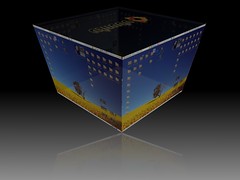Spring break this year provided time for a needed format and reinstall. Leaving were an old install of windows x64 that I hadn’t used in a year or two, the current windows xp which I booted most often in case I wanted some photoshop tools, and an install of suse 10.2 that I hadn’t used much since I finished my C course last April.
I did the backup, Rob did the reinstall but by the time that was done I had a major paper due so I spent those hours on my laptop instead of the desktop since the laptop was all set to go and the new install of Suse 10.3 would need hours of tweaking (and remembering how to tweak since I’m still a Linux newb).
Finally today I got the machine turned on again and started digging around. I installed my favourite extensions in Firefox:
and decided that it’s time now to put some real effort into del.icio.us for syncing bookmarks. The profile backup I did in Windows with MozBackup won’t be easy to bring into Linux — I figure I’ll have to restore it on a second profile on my laptop then import the bookmarks into Delicious. If only I’d saved the bookmarks.html file before I formatted…
I also decided to install Chatzilla — since I’ve joined LinuxChix and plan to join in the irc there.
Then it was over to Thunderbird to start setting up some email and the addon I’ve been missing the most: Lightning. Lightning is the schedule, task and calendar add-on that works inside of Thunderbird. I started using it in the late fall and it was exactly what I’ve been needing. There’s a quick task list that is visible from the mail pane and the calendar allows multiple calendars so that I can categorize and track the many activities and people in the house (and my own multiple identities – heh).
I downloaded Lightning without any problem but it wouldn’t install because I’m running 64-bit Linux. Then I found this hack:
Hack for 64 bit Linux users
by p stucke on March 15, 2008 (rated 10)
This add-on can be installed on a 64 bit Linux system with a small hack.\n\n1. Extract the archive to a folder.\n2. Open install.rdf in a text editor.\n3. Change the following line: Linux_x86-gcc3\nto\nLinux_x86_64-gcc3\n4. Save the file.\n5. Zip the contents (not the entire folder, just the contents) of the folder.\n6. Rename the archive to: lightning-0.7-tb-linux_64.xpi (or something similar)\n7. Install the add-on.\n\nThat\’s it. Upon first launch, the GUI loaded incorrectly, but after a restart, it worked as expected.
Written just 5 days ago and here was the key I needed to get my Lightning working! It took some decoding to unscramble that hard-to-read formatting (\n = new line) but here’s what I realized p stucke was saying:
- Extract the archive to a folder.
Did this by right clicking selecting “extract to” and extracting all files into a folder in my home directory (the default location)
- Open install.rdf in a text editor.
Navigated to my home directory, found the folder and file, right click > Open with > Other > Utilities > Editor > KWrite. There may have been other choices sooner but this is the one I was familiar with.
- Change the following line: Linux_x86-gcc3 to Linux_x86_64-gcc3
Found that line at the bottom of the document and typed in the changes.
- Save the file.
No problems here, just saved and closed KWrite.
- Zip the contents (not the entire folder, just the contents) of the folder.
Selected everything in the folder, right clicked then Compress > Compress as > Zip Archive.
- Rename the archive to: lightning-0.7-tb-linux_64.xpi (or something similar)
Good old F2, same as always.
- Install the add-on.
Back to Thunderbird > Tools > Add-ons> Install > navigate to the home folder with the new zip and Open. Everything worked on the first try!
So now it’s just a matter of setting up my tasks and calendars — and all my email addresses of course. 😉
I’m pretty happy.

